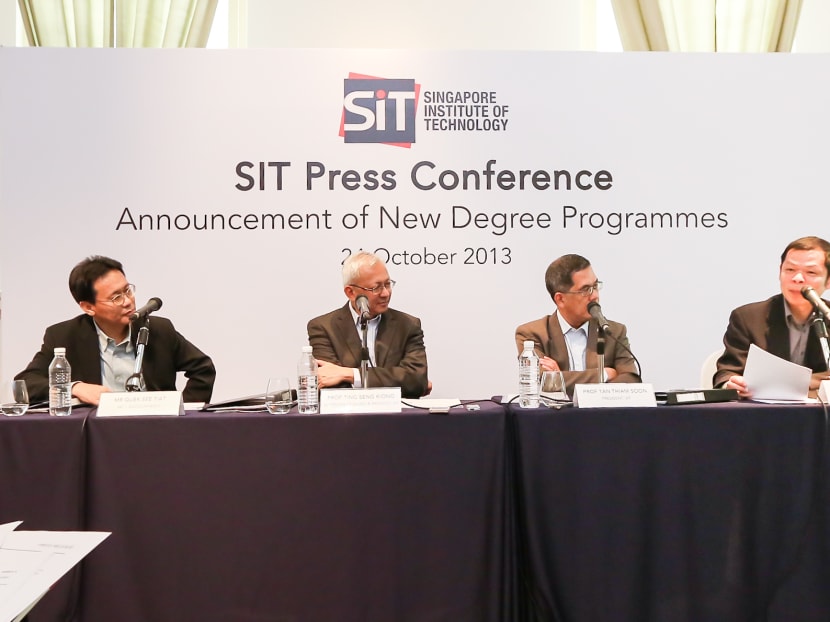SIT to offer own degrees, turn out more graduates
SINGAPORE — Enrolment at the Singapore Institute of Technology (SIT) could be doubled to at least 10,000 students, with the university having its own campus and residential facilities by 2020, as part of the Government’s push to raise the number of university places to meet growing demand for higher learning among Singaporeans.

Come 2014, the Singapore Institute of Technology (SIT) will offer its own degrees for the first time. Photo: SIT
SINGAPORE — Enrolment at the Singapore Institute of Technology (SIT) could be doubled to at least 10,000 students, with the university having its own campus and residential facilities by 2020, as part of the Government’s push to raise the number of university places to meet growing demand for higher learning among Singaporeans.
Next year, SIT will offer its own degrees for the first time, a move away from providing niche degrees from foreign universities. The three new full-time degree programmes are in the areas of sustainable infrastructure engineering, information and communications technology and accountancy.
SIT President Tan Thiam Soon, who laid out these plans yesterday, said Singapore’s fifth autonomous university will be among the institutions that will admit “the major share” of the planned increase in student intake.
Prime Minister Lee Hsien Loong had announced at last year’s National Day Rally that by 2020, 40 per cent of each school-going cohort will be able to have a university education, up from the current 27 per cent. The annual intake would be increased by 3,000 places, up from the current 13,000 to 16,000.
“SIT has a very important role to play in helping many of our very able students to receive a high quality university education that will prepare them well for the Singapore economy long into the future,” Professor Tan said. “In the process, we expect our students to contribute to the vibrant Singapore economy.”
SIT is drawing up plans for its own campus that may house all its programmes and faculty at a single site. By 2020, the university hopes to have between 300 and 400 faculty members — 10 times the number now.
Currently, SIT has about 3,000 students enrolled in 27 undergraduate degree programmes offered by overseas institutions.
The student population is spread across the five local polytechnics, which serve as satellite campuses.
Prof Tan said the university is working with the authorities to finalise a timeline and location for its main campus, but he hopes it will feature an enterprise hub for students to work with small and medium enterprises.
The sustainable-infrastructure engineering course allows students to obtain a master’s degree by studying an additional year. SIT said those enrolled in any of its three degrees — to be offered next year — and have the relevant background can graduate in two-and-a-half to three-and-a-half years. Classes will be held during term breaks to help students graduate sooner.
Undergraduates will also spend eight months to a year as part of an integrated work experience, during which they can combine industry attachments with their studies.
For instance, accountancy students could work at an auditing firm on weekdays to get a feel of the audit peak period between September and April. On weekends, they could then return to campus for classes. The university is still working out the details.
On the roll-out of the three courses, Prof Tan felt there would be demand for specialists in sustainable-infrastructure engineering as Singapore develops its infrastructure, such as its rail network.
Students are also eligible for professional certification after their master’s degree, he added.
The information and communications technology programme allows students to obtain a professional industry certification upon graduation, while accountancy students will be exposed to firms in the Asia-Pacific region through study tours and visits.
For a start, SIT will admit 75 students each in accountancy and engineering, while the information and communications technology course will offer 50 places.
The university will not impose a quota on the number of diploma and A-level holders to be admitted, but Prof Tan noted that it would be a “more seamless journey” for polytechnic graduates due to the programmes’ hands-on nature. The courses will be held at the SIT headquarters in Dover and Singapore Polytechnic. Correction: The original article stated that SIT currently has 4,000 students enrolled. This is incorrect. SIT has clarified that it has 3,000 students enrolled. This article was edited at 1154am on Oct 25, 2013.






